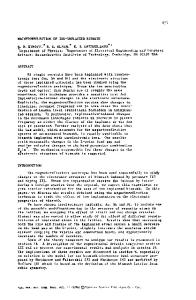Optical Activation of Ion Implanted Rare-Earths
- PDF / 624,613 Bytes
- 13 Pages / 414.72 x 648 pts Page_size
- 53 Downloads / 337 Views
OPTICAL ACTIVATION OF ION IMPLANTED RARE-EARTHS P.N. FAVENNEC*, H. L'HARIDON**, D. MOUTONNET**, M. SALVI** AND M. GAUNEAU** *France Telecom, CNET, DIR/SAS, B.P. 40, F-22301 LANNION "**FranceTelecom, CNET, LAB/OCM, B.P. 40, F-22301 LANNION
ABSTRACT A review of the main results concerning the ion implantation of the rare-earth elements is given. To obtain the best optical activation of rare-earths, we attempt to optimize the implantation (energy, dose) and annealing (temperature, duration) conditions. The studied materials are Si, II-VI binaries (ZnTe, CdS), III-V binaries (GaAs, InP), III-V ternaries (GaAlAs, GaInAs) and III-V quaternaries (GaInAsP). 1 - INTRODUCTION The semiconductor rare-earth (RE) element system exhibits some interesting properties that are of potential importance for nowadays semiconductor technology. One of the main characteristic features of rare-earth ions is the partially filled inner 4 f shell where the f electrons are screened by the closed 5s2 and 5p shells. As a consequence, the characteristic sharp transitions of these electrons are highly insensitive to their environment, giving rise to a: - sharp luminescence even at relatively high temperatures, - photon energy of their luminescence independant of host semiconductor materials and temperature. Optical properties of rare-earth impurities in silicon, in Ill-V materials and IIVI semiconductors have recently attracted much attention. Rare-earth doped materials belong to a new class of materials for optic or optoelectronic devices. Incorporation of erbium into a semiconductor is of particular interest as the 1.54 pm Er3+ emission is applicable to the low-loss region of silica-based optical fibers. Erbium emission from various semiconductors have been the subject of numerous investigations [I to 10]. The rare-earth ytterbium, neodymium, thullium... have also been studied [11 to 14]. In this paper, the optical activation of rare-earth elements, mainly erbium, implanted in various semiconductors, is presented. The ion implantation is recognized as a most useful tool in fabricating devices. 2 - CHEMICAL IN-DEPTH PROFILES In order to apply this technique to devices, it is necessary to know the chemical distribution of implanted impurities in the target materials. In the process of ion implantation, atoms of the desired rare-earth element are ionized and accelerated to high velocity. After the energetic ion comes to rest and equilibrium has occured, the implanted atoms can be in a position in which they
Mat. Res. Soc. Symp. Proc. Vol. 301. ©1993 Materials Research Society
182
serve to change the optical properties of the host material. Factors such as the ion energy, ion species and target density influence the range distribution. For the determination of the chemical in-depth profiles, SIMS is the most popular technique used ; this existing fact is due to the combination of high sensitivity, acceptable quantitativity, and good depth and lateral resolution. The rare-earth elements are high mass (from M = 140 for cesium to M = 174 for luteti
Data Loading...









